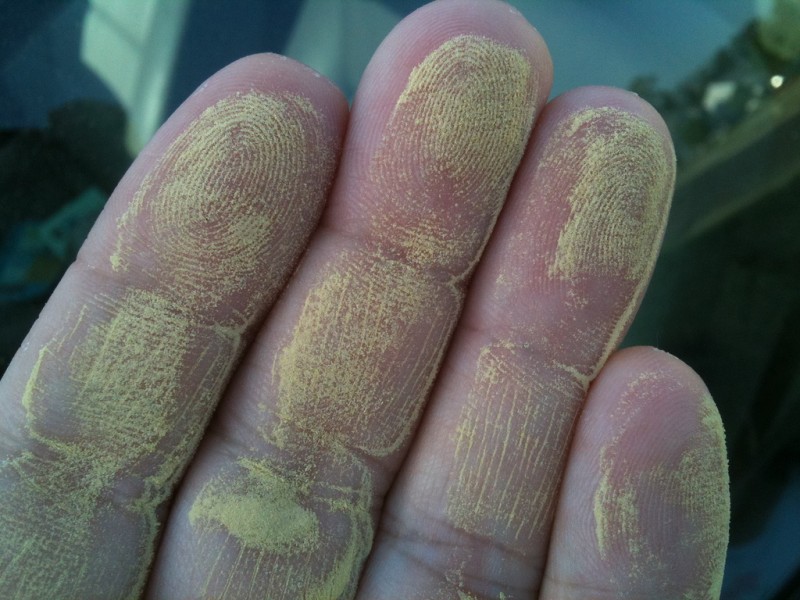Sniffling and sneezing? Too many male trees are (partly) to blame.

Pollen, ugh. Image by Alastair Vance licensed under Creative Commons.
With February's early warm weather, DC's pollen counts are climbing earlier than usual. What you might not know is that decades of urban landscaping sexism are partly to blame for high pollen counts.
That's tree-based, not people-based, sexism. Some common types of trees used in urban landscaping are dioecious, meaning individual trees are either male or female.
When it comes to dioecious plants, cities tend to prefer planting males to females because females drop fruit or seeds that the city then needs to clean up. The most notorious female offenders are gingko trees, whose undesirable smelly fruit plague residents with “strong notes of unwashed feet and Diaper Genie, with noticeable hints of spoiled butter.”
But male dioecious trees don't drop seeds or fruit. Instead, in the spring, they release pollen.
Gingkos, a dioecious species, line Swann Street NW. Image by Jean & Oliver licensed under Creative Commons.
Horticultural epidemiologist Tom Ogren traces the modern preference for male trees to around 1950, when the USDA released a book that promoted planting male trees over female trees for easy, litter-free maintenance. The idea caught on with private homeowners, nursery suppliers, and city planners. At the time, Dutch Elm disease was on the uptick, and swaths of trees in US cities were being replaced. Today, DDOT's Design and Engineering Manual (section 47.4.4) confirms that “…trees near walks should be thornless and fruitless to minimize maintenance,” though of course there are plenty of fruitless trees that aren't dioecious males.
Favoring male trees isn't a bad idea in itself, and Ogren believes no one had any bad intentions. “But when a city does this on a massive scale, it has a huge impact on the health of the people who live there,” he said to Governing. Ogren, who developed the Ogren Plants Allergy Scale (OPALS) used by the USDA and American Lung Association, says planting more female trees will reduce the pollen count in a city.
That makes sense. The job of female trees is to capture pollen, essentially acting as natural air filters. But when they're nearly non-existent, we're left with a ton of pollen in the air with no females to trap it.
Of course, if cities are concerned about street litter, they have some alternatives, Ogren told CityLab. They can use sterile female trees, which don't produce fruit. They can also graft or prune male trees into female trees.
And yes, for allergy sufferers, your proximity to different tree types can matter. Even wide-spreading types of pollen tend not to spread beyond a half-mile of their source. The bulk of a tree's pollen is deposited within a 100-foot radius of the tree.
Red maples are also a relatively common dioecious species in DC. Image by Susy Morris licensed under Creative Commons.
To be fair, the most common trees in DC aren't dioecious at all, explains Dr. Jessica Sanders, the Director of Research at Casey Trees. She says DC tends to plant more monoecious trees; that is, trees that share male and female parts on the same tree. Birch and oak trees are both monoecious, as are our tourist-favorite cherry trees.
The dioecious trees most popular in DC are poplars and ginkgos. Other dioecious varieties you might see around DC from time to time? Willows, holly, juniper, pistache, and sassafras. Also present in DC, and the releasing their pollen right now? Red maples.
If you're sneezing up a storm like I have been recently, Dr. Sanders says you probably have red maples to thank.
What kind of trees are on your block? DDOT's Urban Forestry Administration has excellent open data on street trees. It's so good, in fact, that in 2011 David Alpert wrote this post about the map Casey Trees made from the data. Dr. Sanders confirmed the map is still pretty accurate:
While other factors outside of pollen also impact seasonal allergies and air quality, there's no wonder I'm digging into my stock of antihistamines since I'm very sensitive to tree pollen. I'm lucky enough to have both a holly tree and a red maple directly in front of my apartment.
